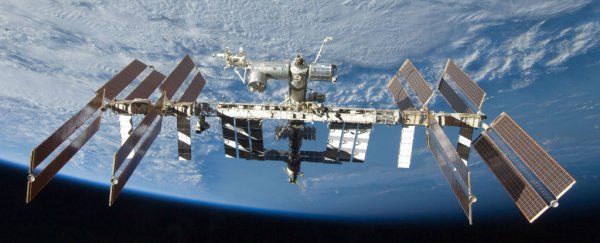It's something that no one can explain right now, but scientists have found that of the 48 harmless bacteria strains they've been raising on the International Space Station, one has not just adapted to its new microgravity environment some 400 km above Earth - it prefers it.
According to a new study, Bacillus safensis JPL-MERTA-8-2 - a strain that was first discovered on one of the Mars Exploration Rovers at the Kennedy Space Center in Florida before they launched in 2004 - grew an impressive 60 percent better in space than the control colonies on Earth, and it's not yet clear why.
The most obvious difference between the two environments is gravity, but as David Coil, a University of California, Davis microbiologist and lead researcher on the project, told Becky Ferreira at Motherboard, it's highly unlikely that gravity makes any difference to individual microbes, seeing as they're so incredibly minute.
"Bugs are pretty small, so gravity is not a major determining factor on their day-to-day metabolism and physiology," he said.
But perhaps something that doesn't affect an individual in any discernible way can have a significant effect on the larger community.
"My guess is that something like that is going on here, where for this bug [B. safensis], there's something about less gravity that is favourable to its growth as a community," he told Motherboard. "But to really get at it, you'd want to send that bug back up there under some different conditions and maybe have [the ISS crew] do some more in-depth experiments."
Interestingly, while the 47 other strains of bacteria did not thrive as incredibly as B. safensis out in space, they didn't appear to suffer much at all either. "We sent up a collection of bugs and most of them pretty much did the same things that they do on Earth," Coil says. "I find that sort of conceptually reassuring."
The results of the study have been published in the journal Peer J, and now the next step will be to perform more complex tests with the microbes, and start testing for specific factors to try to narrow down what the microbes respond to most strongly. Coil and his team have already sequenced the genome of B. safensis to help them figure out what makes it tick.
B. safensis is a pretty fascinating little bug. You might assume its species name refers to its non-pathogenic qualities, but it was actually named after the Spacecraft Assembly Facility (SAF) at NASA's Jet Propulsion Laboratory, where it was originally discovered.
It's thought that some B. safensis microbes actually made it to Mars as stowaways on NASA's Opportinty rover back in 2004, because while scientists take big precautions to make sure whatever they send into space is clean, they can never guarantee that every surface is 100 percent contamination-free.
That's why these experiments aboard the ISS are so important - if ensuring that every tiny microbe has been removed from the things we blast into our outer space neighbourhood is practically impossible, we need to know what they could do in the event that they make it to another planet or moon.
And if we're going to be colonising the Moon within seven years, like experts say is actually possible, maybe species that seem to love the environment would be a good thing to have around.
